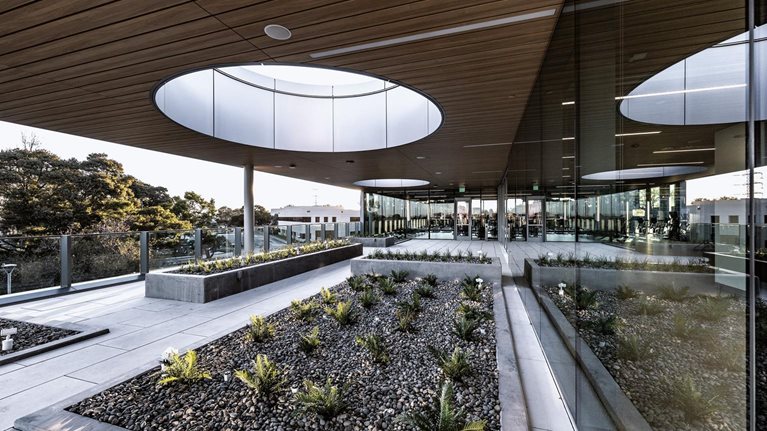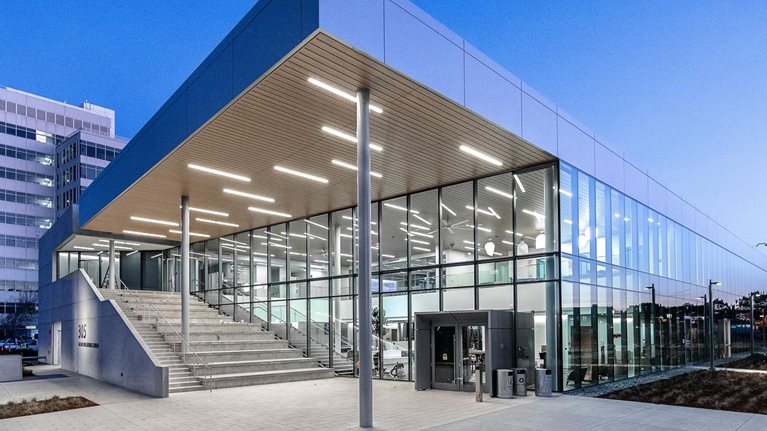JPMorgan Chase (JPMC) is constructing a new, state-of-the art, 60-story global headquarters at 270 Park Avenue in Midtown Manhattan. McKinsey partner John Means sat down with David Arena, JPMC’s head of global real estate, to discuss the new tower, as well as the company’s Workplace Lab, where it is experimenting with futuristic office technology and concepts (see sidebar, “A laboratory for the workplace of the future”).
Companies that are purposefully fostering belonging, connectivity, creativity, and wellness for their employees can yield higher performance, which is why synthesizing technology, workplace design, and employee experience is crucial to success. Means and Arena discuss how JPMC is pursuing these goals and why today, more than ever, workplaces need a purpose. The following is an edited version of their conversation.
McKinsey: These days, we’re constantly talking to companies about how every office needs to have a purpose. What’s the purpose of 270 Park Avenue?
David Arena: We believe that when we are together in a place and that place is purpose-built and we’re there together for the moments that matter, we can’t be beat.
This office has lots of reasons for being. The first and foremost is it’s a house for employees. It’s a house for people, it’s a house to bring clients to, to bring guests in, it’s a place to do business. It’s the manifestation of the brand in the physical environment. Everything you look at, everything you hear, smell, taste, touch, is part of JPMorgan Chase and part of that experience. You could say it’s a place to have an experience.
It’s a place for our senior-most people to lead their teams, and it’s a place for people to come to work, to be with one another, to share culture, to share knowledge, to cocreate the future of their businesses, and to bring dreams to life for their clients.
McKinsey: Let’s say I walk into the building for the first time. What’s going to strike me as new and innovative?
David Arena: The minute you see it from the sidewalk, you’re going to feel a lot different. Our building is purposefully lifted off the sidewalk by 100 feet. We didn’t have to do that, but we did it to make it more spacious, to welcome the community in, and to give people a feeling of light and air in the middle of the city.
We’ll have a thousand bike racks for people who want to come to work by bicycle. And we have a designated lay-by lane for self-driving cars, so that when that happens, we’re ready for it.
I think one of the things we’ve missed in office buildings is that people want to be known. They want to be recognized, they want to be welcomed in the morning, quite frankly, by name. They want to have a personal experience when they come to work, and I think there’s a great opportunity to do that.
It’s not much different from when you go into a great restaurant or a great hotel and somebody meets you and they know your name. They’ve been expecting you. So, technology is really important for knowing when people come in. The way a place smells, quite frankly, is really important to me, and I think it’s important to people. We’ve done lots of due diligence on aromatherapy.
Great hospitality is a series of small moves. It’s the lighting, it’s the ergonomics of the chair you’re sitting in, it’s the sense that there are other living things around you, like plants, it’s the smell of something, it’s the amount of natural light that comes into a space, it’s the way the carpet or the floor feels underfoot.
McKinsey: That sounds much more comfortable and personalized than offices in the past. But with attendance rates of below 50 percent in most major metro areas, some employees will still be skeptical. Can you make a case for coming into the office?
David Arena: One of the great reasons to come to the workplace is to be in physical proximity to folks that you can learn from. This is particularly true for younger people who want to learn their craft. Think back on your own career to a great manager or a great coach you had. Those learnings are key.
We think they happen best in person, and so we’ve dedicated almost 200 percent more space in our new headquarters to those kinds of interactions—for example, the interactions where a senior executive gets the opportunity to transfer knowledge to an emerging executive. We have those spaces connected throughout the building.
The connection, the knowledge transfer, the ability to think out loud with others, is so important. Most creation happens like this. It’s iteration. It’s how we got to the moon. It’s error, correction, error, correction.
How do you really do that well on video calls, or how do you do that well remotely? It can be part of it, so we have solutions for hybrid working, we have solutions for people who are at home. We even have parts of the company that work at home full-time. Another portion works at home one or two days a week. But there’s probably 50 percent of our company that’s in the office every day; our traders, our retail bankers, our support staff—they’re in the office. That’s where the game is.
Our statistics for people coming back to the office are really high for Tuesday, Wednesday, and Thursday. The hard parts are trying to figure out Monday and Friday right now.
McKinsey: One of the most common criticisms we’ve heard about on-site work is that it doesn’t always unite people; you could just end up with workers messaging each other from their desks. How can you facilitate collaboration through your real estate?
David Arena: We’ll have a floor which is essentially where half the traffic in the building will collide during the day. It’s designed like a transportation hub, with places where you can meet a friend, have a cup of coffee, maybe even have a drink.
That’s right in the middle of the building. Above those floors, in the middle of the building, are these incredible conference floors, and those conference floors are places where we will have guests. We’ll have guest speakers, places to learn, and client events.
All of that sort of mixes like this grand mélange right in the middle of the building. It’s like a great stew of humanity in the middle of the building, and that includes leaders, guests, clients, etcetera. It’s a place to exchange ideas and warm greetings and camaraderie and to build culture and esprit de corps.
McKinsey: Let’s talk about remote workers, those who are either full-time or part-time. How will you address their needs and integrate them with the on-site workers? And as the concept of flexible work evolves, how can you make sure your real estate can evolve with it?
David Arena: When people want to stay home or need to work remotely—because that is where heads-down work is really done well—we’re going to have tools for them to connect to the office, as if they were there, in a democratic way, in a way in which they still feel the culture, where it’s palpable to them. That’s our job: to create workplaces that enable culture and creativity and productivity, maybe happiness even.
I am really excited about virtual reality and augmented reality and their use in distance officing. They help make you feel like you’re together. The tools are not ready to roll out yet, but we are putting all the things in place at 270 Park to use them when they are ready.
The key thing about technology and about thinking through the future of the workplace and the future of work is to make things as flexible and as modular as you can. You have to view buildings and real estate like a machine, a tool, or a lever. You have to build them in such a way that they could be changed for any generation at a reasonable cost, so that buildings don’t become antiquated.
If you come into a well-designed office space these days, you really have two planes: a floor plane and a ceiling plane. Everything else on the floor, if you design it correctly, is furniture. The walls are furniture, they come prewired or with glass. Any such furniture can be moved around.
McKinsey: How are you responding to greater demands today for buildings that are healthier, both for residents and for the planet?
David Arena: We have the largest corporate solar array in the United States. We have a 15-megawatt solar array in Ohio. Five years ago, the leadership of this firm made a commitment to create as much renewable on-site generation as possible. We have been busy for the last five years creating renewable, on-site generation, and we’ve experimented with almost every idea. It does come down to solar, wind, and maybe some yet-to-be-discovered battery power that works without burning fossil fuels. All those ideas will be part of 270 Park.
Elevator, security, air handling, sensoring, lighting systems, etcetera—they’ve been around for the last 70 years. But today, each one of those systems is smarter than it’s ever been. At 270 Park, we’re going take every one of those incredibly smart systems and we’re going to roll them up into a more intelligent way of running a building, a system that is all about automated intelligence, all about learning from itself.
For instance, if it were too hot in here, that shade would come down if it was a certain time of the day. The variable-frequency drive on the fan would engage. There would be more outside air in the room, the lights may be dimmer—all of those systems would work together. This building is also going to have 2.5 times more outside air than any comparable facility that I’m aware of in the world.
When you come into the building, you may work your way through a security device that knows who you are by facial recognition or by some other biometric marker. And it’ll be able to call an elevator just for you. That elevator will know where you like to go in the morning—it might drop you off near a coffee shop in the building. And that coffee shop in the building might know, via your cell phone, that you’re in the vicinity and might make your coffee for you.
We haven’t thought about all the ways that a building can be smarter. But the idea of a smart building is kind of passé. Even an intelligent building—those are table stakes. Today, it’s about the intuitive building, and that’s what we’re working on.
McKinsey: You’re a global company and many of your stakeholders will never even visit New York City. How is what you’re learning by planning for 270 Park going to benefit them?
David Arena: We have a community that we call MyWorkplace. It’s an app, and we’re already using it and making it better. The idea is to create a community. We don’t just do this here at 270 Park, we’re doing it worldwide.
We’re building similar campuses in Bengaluru and Mumbai. We just built campuses in Hyderabad and Manila that have all the same attributes. We built one in Singapore.
We’re also expanding our retail branches. We went from something like 28 [US] states to having a presence in nearly every state in the nation in just the last three or four years. When we build a new branch, we think about how clients will feel when they come in. We think about how those branches connect to the community. We call many of them community centers, not branches.


